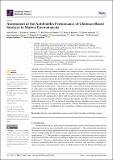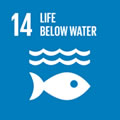Por favor, use este identificador para citar o enlazar a este item:
http://hdl.handle.net/10261/285828COMPARTIR / EXPORTAR:
 SHARE SHARE
 CORE
BASE CORE
BASE
|
|
| Visualizar otros formatos: MARC | Dublin Core | RDF | ORE | MODS | METS | DIDL | DATACITE | |

| Título: | Assessment of the Antibiofilm Performance of Chitosan-Based Surfaces in Marine Environments |
Autor: | Lima, Marta; Gomes, Luciana C.; Teixeira-Santos, Rita; Romeu, Maria J.; Valcárcel Barros, Jesús CSIC ORCID; Vázquez, José Antonio CSIC ORCID; Cerqueira, Miguel A.; Pastrana, Lorenzo CSIC ORCID; Bourbon, Ana I.; de Jong, Ed D.; Sjollema, Jelmer; Mergulhão, Filipe J. | Palabras clave: | Antifouling coatings Biofilm formation Chitosan Marine biofouling Marine waste |
Fecha de publicación: | 24-nov-2022 | Editor: | Multidisciplinary Digital Publishing Institute | Citación: | International Journal of Molecular Sciences 23(23): 14647 (2022) | Resumen: | Marine biofouling is a natural process often associated with biofilm formation on submerged surfaces, creating a massive economic and ecological burden. Although several antifouling paints have been used to prevent biofouling, growing ecological concerns emphasize the need to develop new and environmentally friendly antifouling approaches such as bio-based coatings. Chitosan (CS) is a natural polymer that has been widely used due to its outstanding biological properties, including non-toxicity and antimicrobial activity. This work aims to produce and characterize poly (lactic acid) (PLA)-CS surfaces with CS of different molecular weight (Mw) at different concentrations for application in marine paints. Loligo opalescens pens, a waste from the fishery industry, were used as a CS source. The antimicrobial activity of the CS and CS-functionalized surfaces was assessed against Cobetia marina, a model proteobacterium for marine biofouling. Results demonstrate that CS targets the bacterial cell membrane, and PLA-CS surfaces were able to reduce the number of culturable cells up to 68% compared to control, with this activity dependent on CS Mw. The antifouling performance was corroborated by Optical Coherence Tomography since PLA-CS surfaces reduced the biofilm thickness by up to 36%, as well as the percentage and size of biofilm empty spaces. Overall, CS coatings showed to be a promising approach to reducing biofouling in marine environments mimicked in this work, contributing to the valorization of fishing waste and encouraging further research on this topic. | Descripción: | 18 pages, 6 figures.-- This article is an open access article distributed under the terms and conditions of the Creative Commons Attribution (CC BY) license | Versión del editor: | https://doi.org/10.3390/ijms232314647 | URI: | http://hdl.handle.net/10261/285828 | DOI: | 10.3390/ijms232314647 | ISSN: | 1661-6596 | E-ISSN: | 1422-0067 |
| Aparece en las colecciones: | (IIM) Artículos |
Ficheros en este ítem:
| Fichero | Descripción | Tamaño | Formato | |
|---|---|---|---|---|
| Assessment_antibiofilm_OA_2022.pdf | 3,36 MB | Adobe PDF |  Visualizar/Abrir |
CORE Recommender
PubMed Central
Citations
4
checked on 29-abr-2024
SCOPUSTM
Citations
4
checked on 24-abr-2024
WEB OF SCIENCETM
Citations
4
checked on 24-feb-2024
Page view(s)
27
checked on 02-may-2024
Download(s)
65
checked on 02-may-2024



